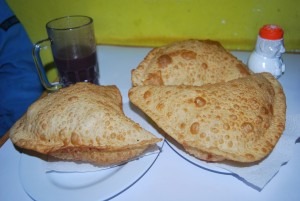Api: Warmth, Migration, and Tradition

Night, cold, and difficult times find a solution in Cuzco in api [áh-pea], a hot, fruity, corn-based drink. Stemming from pre-Columbian times, api is most known on the high, chilly plateau by Lake Titicaca, especially on the Bolivian side. From there is spread to Juliaca and Arequipa as well as, now, Cuzco.
Mrs. Justina Carhuarupay, who is from Juliaca, tells us how she began making and selling api some fifteen years ago. She had travelled to Bolivia to visit her sister who lives on the Altiplano. While in Bolivia she learned how to make this delicious drink from her sister who arises early in the morning to make it and sell it there, where api is drunk before or at dawn.
Upon returning to Juliaca and seeing that people there also made and sold api, Mrs. Carhuarupay had a cart put together and too to the streets to sell this steaming beverage. Some ten months ago she came to live in the city of Cuzco and opened a cafe selling api on the Jiron de la Union in suburban Wanchac. Evenings, Mrs. Carhuarupay opens her doors to offer rich smelling and tasty, hot api accompanied by an empanada, a pastry, with a bit of cheese in it.

The combination of flavors — the dry pastry, puffed up and served at the same temperature as the air, with a bit of salt to it, along with the steaming hot api, sweet and dense — is not only exquisite but marks a combination of difference. Hot and cold, airy and dense, dry and wet, salty and sweet, as if the Parisian master Levi Strauss had designed it himself.
To make this rich beverage one needs orange cinnamon sticks, whole cloves, and ground purple corn, orange or pineapple juice, lime juice and sugar.

One sets water to boil, in order to make this delight, with cinnamon and cloves. One carefully dissolves the corn flour in cold water and only then carefully introduces it into the boiling water carefully in order to avoid lumps. Once it is all dissolved and boiling, one adds sugar to taste and waits for the drink to thicken. It should not get too think, staying runny, but also must not be too thin; it must have substance. Finally one adds the orange or pineapple juice and a little bit of lime juice.
Increasingly this drink is being enjoyed and recognized by the population of Cuzco as a great option to fight the cold on those chilly nights when coats, hats and scarfs blossom. It is appearing on more streets and becoming part of the code of Cuzco street food.

Since, just as in the past, Cuzco continues to be a center of art and popular food, this delicious drink returns to the cosmopolitan city of Cuzco where in the past it was consumed, such as in the time of Garcilaso Inca de la Vega who mentions api.
Fruited api made from purple corn was a desert in Inca times. And, when resurrected won first place in the fourth “Dulce Peru” competition held in 2010, which was carried out on the Plaza de Regocijo in the city of Cuzco.
This desert representing Cuzco in the Dulce Peru contest was prepared by Pedro Alegría de la Cruz, chef of the Casa Andina Hotel. He says it is a sweet that precedes the famous mazamorra morada which in Inca times was even eaten with hot peppers to generate thirst for the famous chicha de jora, or indigenous corn beer.
Api frutado ( or fruited api) requires corn flour, fruit (guanabanas, pears, peaches, and pineapples, addorned with paper of corn and yellow aji). It takes about forty-five minutes to prepare.




